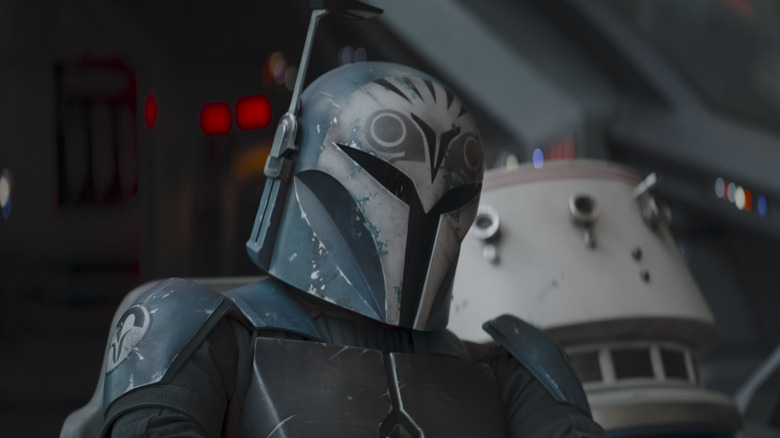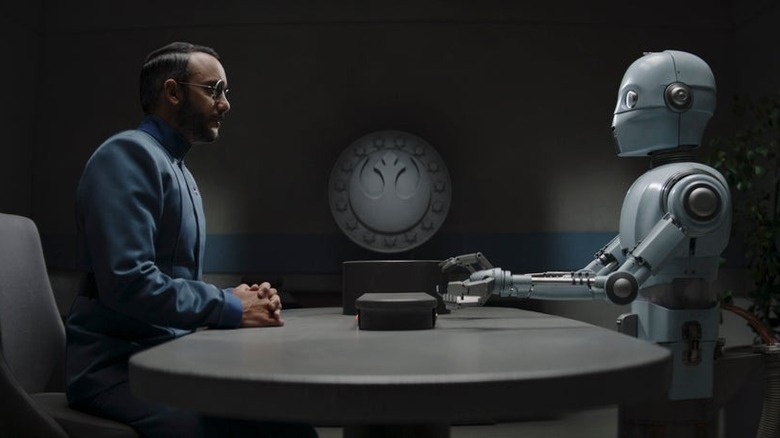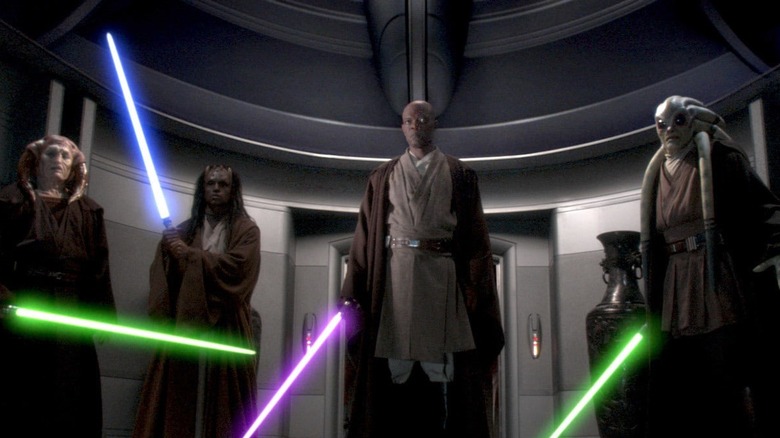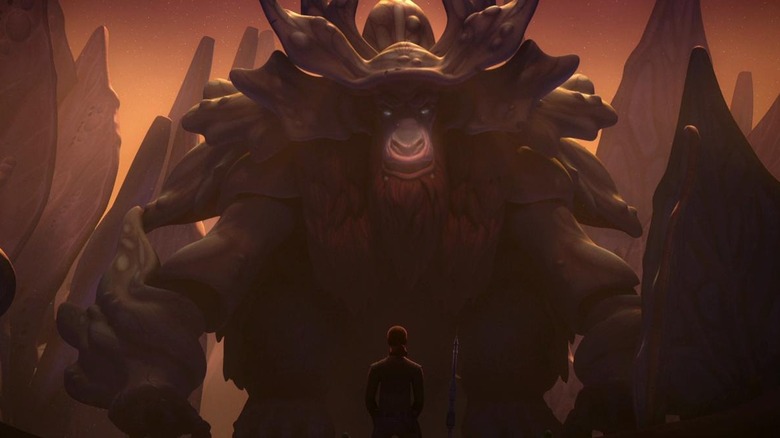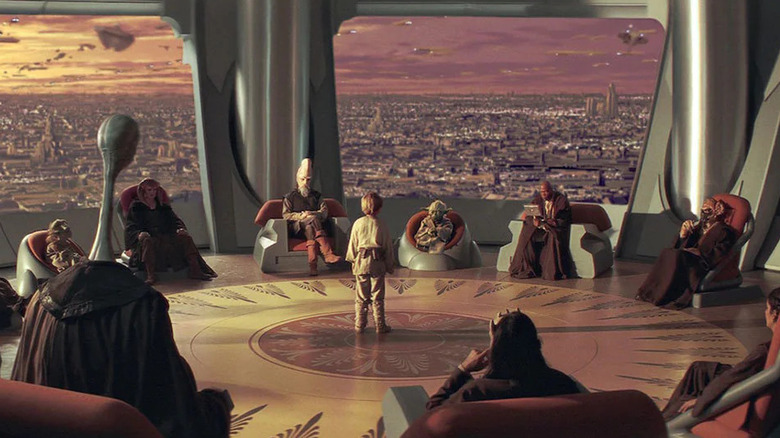The Mandalorian Made A Star Wars Legends Nod To Taungsday And Benduday
What the heck are Taungsday and Benduday? To explain, a recent episode of "The Mandalorian" finally canonized the Galactic Standard Calendar that long existed in the "Star Wars" archived Expanded Universe, the Legends. In season 3, episode 3 "The Convert," the show diverts from its eponymous Mandalorian and his famed foundling Grogu to focus on a reformed ex-Imperial, Dr. Pershing (Omid Abtah), figuring out his life on the sparkling capital city-planet of Coruscant. There, we're exposed to casual mentions of Taungsday and Benduday, two days of the week in "Star Wars."
In a 2009 "Hyperspace" fan-club article by Gregory Walker, you can see the days of the week listed out in this order on the "Dining at Dex's" menu: Primeday, Centaxday, Taungsday, Zhellday, Benduday. That's right, the galaxy far, far away comprises five days in a week. To us Earthlings familiar with the seven-day week, the weeks sure sound short in "Star Wars."
Taungsday and Benduday also share a long storied history in the "Star Wars" Legends archives. Strap in, "Star Wars" fans — this may be handy for a pop quiz.
Taungsday, am I right?
"Taungsday, am I right?" Pershing tells a Coruscant civilian in a futile attempt to come off as casual. Interestingly, the word "Taungs" offers a twofold Legends homage concerning both Coruscant and Mandalorian lore. Eons before Coruscant became the capital of the Republic, there lived the native gray-skinned humanoid species known as Taungs. They warred against the native Zhells (possible ancestors of humans) who eventually drove them off planet. After immigrating to the moon Roon, the Taungs subsequently conquered the world that would be called Mandalore under the leadership of Mandalore the First, a Taung who was said to have worn the ceremonial "Mandalore's Mask" made from the mythosaur bone. While the Taung species eventually became extinct, their clan-based, warrior, and nomadic practices had an incalculable impact on modern Mandalore's culture, including their language, chants, and (you guessed it) the T-visored helmets ubiquitous among Mandalorian warrior fractions.
By the way, yes the Zhells probably inspired the "Zellday" that comes after Taungsday in the week, almost like a history gag. If the Taungs were still around, they may not take kindly to that weekly system.
The 2016 magazine "Star Wars: Build the Millennium Falcon" issue no. 61 (published by De Agostini) acknowledges the Taungs in the reset canon. The history of Taungs might or might not be reimagined in the canon displayed in "The Mandalorian." Regardless, the initial implications that the first Mandalorians were not the helmed and armored humans — like the one we see today — would make for complex origins.
Happy Benduday!
Benduday is first heard as "Happy Benduday!" in Dr. Pershing's workplace. If you read George Lucas's original drafts for "Star Wars," the "Jedi" were referred to as the "Jedi Bendu." Dating back to a 1974 draft, the nearly extinct Jedi Bendu warriors operated as "personal bodyguards of the Emperor" and also "chief architects of the invincible imperial space force." What, the Jedi-Bendu were loyal to "the Empire"? You read that correctly. The democratic Republic in the official "Star Wars" timeline wasn't present in those older drafts. But Lucas' prequel trilogy and "The Clone Wars" cartoon did flesh out the complexity that the Jedi "peacekeepers" once served a corrupted government's military goals.
While the Jedi-Bendu name was simplified into the iconic Jedi title, the "Bendu" name was recycled for other parts of "Star Wars" Legends lore. The Order of Dai Bendu was documented as a proto-Jedi organization that studied the Force. (The hilarious part is that they apparently have organized podraces, a very un-Jedi thing that would amuse Anakin Skywalker.)
The reset canon referenced the Bendu monks in No. 25 of "Star Wars: Build the Millennium Falcon." Canon still nods at the Bendu monks' history as linked to the Jedi's formation. Alex Segura's "Poe Dameron: Free Fall" novel features a millennium-old Dai Bendu Monastery in an era where its monks have long been extinct. Carrying over from Legends, the Bendu numerology studies inspired the Republic's eight-spoke wheel icon (which also resembles the Buddhist Dharmacakra icon).
About that less happy Bendu
In another recycling of the "Bendu," the Empire-era "Star Wars Rebels" cartoon introduced a sentient that calls himself the Bendu (voiced by Tom Baker), a titan Force-sensitive entity with a moose-like, Henson-esque visage that burrows itself in the planet of Atollan. For "Rebels" viewers who might not know of the Bendu monks (because those monks are relegated to non-television supplemental material), they might interpret Benduday as a reference to this beast.
However, in-universe, "Benduday" obviously wouldn't be named after the mysterious and obscure creature who would probably be indifferent to fame. Yet, his shared name with the Bendu monks underlines the Buddhist-influenced ideas of balance that permeate Force philosophies. A neutral force, the creature claims to exist as "the one in the middle," between the light and the dark side, between Jedi and Sith. Mostly, the Bendu's greatest aspiration is just to get some peace — and lots of sleep. And when the Bendu does get angry, he unleashes his Force wrath on both Empire and Rebellion (in the "Zero Hero" season 3 finale).
"Rebels" depicts the Bendu as well aware of Jedi, Sith, their holocrons, and their pesky conflicts. Although the Bendu can advise Jedi if he's in the right mood, we don't know for sure if he played a role in inspiring Force philosophies in other pre-Jedi sentients long before the events of "Rebels."
Legacy of irony
Carrying the legacy of Legends, "Taungsday" and "Benduday" are built on irony. With "Taungs" alluding to the messy war between Coruscanti (proto-)humans and the humanoids that became Mandalorians, it ended up representing the Republic and Mandalorian conflicts displayed in "The Clone Wars," particularly with Emperor Palpatine's scheme to send the Republic's military to occupy Mandalore. When the Republic morphed into the Empire, the Mandalorians faced Imperial adversaries that decimated their home planet. Thus, war with Coruscanti-based forces drove the spiritual descendants of Taungs to other parts of the galaxy.
"Bendu" also represents a fragment of the Jedi legacy. So it's not improbable to consider that Emperor Palpatine, a Darth Sidious in disguise, would have attempted to erase its name just as he tarnished the Jedi's reputation as warmongers and traitors. In addition, Palpatine's reign co-opted the Dai Bendu-inspired symbol of the Republic by removing two of the spokes to form the Imperial crest.
That's the funny thing about the legacy of names and their meaning: they're subjected to bend (haha, bendu) or evolve to mean something else for a different context — sometimes merely a comic phrase like, "Taungsday, am I right?" Like any other sentient on Coruscant, Pershing likely takes its long exhausting origins for granted.
